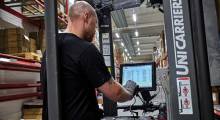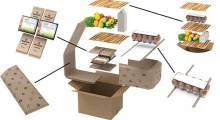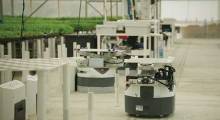Not unlike forklifts and labor, carts were once thrown at peaks and valleys of demand. In-house staff might have cobbled together a few carts as needed, and if a caster made the cart roll, well, that was the right caster. The perception of carts as a necessary evil to keep product moving is changing. As with lift trucks, carts have evolved into specialized tools used in engineered processes to move materials as efficiently as possible.
Yesterday’s simple cart is now a cart system, designed from the casters up to optimize material flow through processes, reconfigure those processes, and ensure as much comfort as possible for the user. The heavy, noisy and unwieldy carts of yesteryear are giving way to customized carts that account for dozens of ergonomic factors. “Ten years ago we thought we were setting the world on fire just by rolling something to the line on a cart,” says Ed Brown, chief engineer at Topper Industrial. “Now, a cart can elevate, rotate, tip and present materials to the operator at the ideal height and distance. The right casters make it even easier to push the cart to the line.”
Reduced strain on the worker is just one way in which carts are being used to increase throughput and improve safety. They are increasingly deployed to reduce the need for lift trucks to work alongside humans on the production floor. In manufacturing, a forklift’s loads can be replaced by smaller, more frequent cart loads that facilitate lean production. In warehousing and distribution, the small and frequent loads that are common to piece picking operations are driving makers of carts, voice-picking and pick-to-light systems into innovative collaborations. Modern spoke with some industry experts to get a sense of how end-users are using carts and casters to move their companies forward.
Build from the caster up
According to Mike Twitty, sales engineer with RWM Casters, any engineered cart system will only be as good as the casters on which it is based. Casters are available in an array of sizes and component materials, but the objectives of the application should make caster selection simple; its impact on rolling resistance, noise or cost will be informed by the overall goals of the engineered cart system.
The wrong tread, bearing, diameter or finish can have a dramatic impact on ergonomics, cart performance and maintenance costs. Too often, casters are one of the last things that are considered, says Twitty. “If you’re carrying an item worth thousands of dollars, it’s usually better to get a caster product that performs exactly as you’d expect,” he says. If customers buy the wrong caster for an application with high heat, corrosive materials or outdoor use, problems will develop quickly.
“It’s not about putting casters on four corners of a frame. A caster is nothing but a tool engineered into a solution,” says Larry Tyler, vice president of sales and marketing for K-Tec, who says there is a vast amount of variation and detail that has to be attacked. “Shopping for casters alone is like telling a conveyor supplier you need conveyor in your whole facility, but you’re going to buy rollers first. You have to consider where casters are placed on the frame, the ratio between pivot points, their static and dynamic ratings. Most people aren’t interested enough to dig into the excruciating details, but that’s what creates a successful program.”
Steve Lippert, executive vice president of Hamilton Caster, says an awareness of these concerns is gradually growing among his customers focused on lean methodologies and reducing the risk of injuries. “You want to make the environment easier to work in, not harder,” says Lippert. “A maintenance associate that has to repeatedly replace cheap casters does not help ergonomics or efficiency.”
Carts are just one of the places where customers look to casters for operational improvements. Keith Soderlund, vice president of sales for Creform, referenced the 5S methodology of workplace organization (sort, straighten, sweep/shine, standardize, sustain/improve the practice). As it turns out, one of the best ways to cover all five bases is to just put everything on wheels, including equipment, workstations, flow racks, display boards, and anything else you might need to sweep beneath.
“Part of it is housekeeping, but it’s also about repositioning,” says Soderlund. “This month, the cell looks like this. But next month, volume has changed or we’re introducing another model. I can unlock the wheels, move things around and reconfigure my work space. Supporting that flexibility is very popular right now.” Many customers say they don’t want anything on feet, he says, and prefer the ability to move things without a forklift or maintenance crew. They want to empower operators and plant supervisors to make adjustments on the fly.
Carts from factory to DC
In warehousing and distribution, Soderlund is seeing a new willingness on the part of customers to develop custom solutions. “In the past, those customers tended to want off-the-shelf solutions,” he says. “They would then adapt their processes to match the cart. Now we’re building the cart around the best process. The continuous improvement philosophy that started in the production area is starting to move into warehousing and distribution.”
In manufacturing, waste reduction initiatives have spurred a transition from batch manufacturing to production cells that bring a product from raw materials to finished product in a much smaller footprint. The old ways resulted in more waiting, more forklifts and much less efficient product movement, Lippert says. Carts designed for the flexibility of mixed production and smaller lots now ferry only what is needed from one process to the next.
According to Brown, carts can also help move product between facilities. When customers come to him, he asks if they’d like to go upstream. “They ask what that means, and I ask: ‘Why not put the carts right on the semi trailer?’” Then, instead of offloading to a cart with a forklift one load at a time, an entire train of carts can be pulled off the trailer all at once. “We’re seeing a lot of this approach. In fact, in some systems we often see raw materials arrive on a cart, the cart follows them through the process, the same cart is used to deliver finished products to a distribution center, and products don’t leave the cart until they are shipped.”
At the DC, Soderlund also notes an increased use of carts in picking applications, which he believes is due in part to the e-commerce boom. “We’re seeing a lot of customers picking high-volume orders and smaller orders,” he says. “To support that, there are a rising number of creative cart-based picking systems integrated with lights and voice.” The customer’s desire for balanced packages has pushed suppliers of carts and picking technologies into closer collaborations than ever before, since if the worker likes the voice but can’t stand the cart, the system will be a failure.
Ergonomics and safety
In warehouse environments, customers want carts to be light, customizable and ergonomically friendly. “The biggest change I’ve seen in the warehouse is the safety and ergonomics side,” says Lippert, who offered the example of carts that mate with forklifts to facilitate picking or putaway in elevated environments. “They used to climb out into the racks to pick a carton, but now they wear restraints and the carts must be fastened positively to the lift. The days of the cowboy in the warehouse are gone.”
In addition to height, reach, pinch points and angled protrusions, cart ergonomics include factors such as noise levels, which can also be impacted through tread and caster selection. “There’s a lot of thought that goes into the human interface,” says Soderlund, who explains that another big safety concern is seen in the growing number of customers who prefer lift trucks stay off the production floor. “As a worker in those areas, I might have the right of way, but they’re bigger, heavier and faster than I am.”
Customers phasing out lift trucks in a process will have to contend with facility constraints, and might want to plan to bevel the corners of aisles or move equipment toward the aisle, instead of having roller lanes 8 or 10 feet from the aisle where a cart can’t pull up alongside. Otherwise, movement will be slowed and cart users will exert more effort. Tyler advises customers to be prepared to make facility changes early, and budget accordingly.
“For some, the last phase of a project is to replace forklifts with carts in a certain application. Carts often become an add-on, and that’s where the constraints become difficult,” he says. “The perception that they’re a commodity puts them at the end of the trail, and in past years, that was probably true. But they’re no longer just carts, they’re cart systems.”
Companies mentioned in this article
Topper Industrial, topperindustrial.com
Creform, creform.com
Hamilton Caster, hamiltoncaster.com
K-Tec, ktecinc.com
RWM Casters, rwmcasters.com







